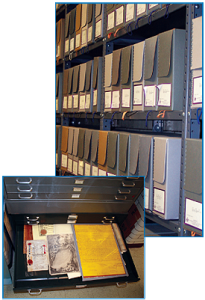By James Hodgkins, 32°, Supreme Council Archives
Right: Archives of the Supreme Council, records in archive boxes and metal document drawers. (Photos: Jeri Walker, Scottish Rite Journal)
The Archives of the Supreme Council are quickly approaching a period of transition. Setting aside the out-dated technologies of the 20th century, it is the intention of Ill. Arturo de Hoyos, 33°, GC, Grand Archivist and Grand Historian, to update how our information is stored, insuring its availability for future generations. A great deal has been accomplished over the past ten years to update and standardize the Archives, but even more remains to be finished in order to safeguard the original sources of our history. The Archives still employ a rudimentary card catalog system dating to the 1960s for most documents. Between transitions of responsibility for the Archives, different filing systems were adopted that are incompatible and lead to confusion when searching for specific documents. There is a great deal that can be done to help modernize the Archives, and the House of the Temple Foundation can greatly assist this process.
The preservation and conservation of our most valuable and rare documents is the primary purpose of the Archives. Unlike a library, which may be open to the general public, an archive normally houses holographs (handwritten documents), manuscripts, and imprints which should not needlessly be handled. Many of the items in our collection are one-to-two-hundred years old and require special handling, treatment, and storage. As items are processed they may require de-acidification and may be placed in ultraviolet-filtered Mylar archival sleeves, protected by a neutral buffer paper. They will be stored in special non-acidic boxes or special metal containers, cases, or drawers. To ensure preservation, only limited access to the Archives is permitted.
While the Archives are a private resource of the Supreme Council and are not available for public access, there is a sizable amount of information that can be made available through digital means. The Transactions of the Supreme Council, the Scottish Rite Journal, and New Age Magazine are resources that have always been available to the public, but one must have a hard copy to access to them. A sizable step in bring the Archives in to the 21st century would be digitization and Optical Character Recognition (OCR) to make these resources accessible and searchable to our Members. The Archives also has a wealth of images on standard film, projector slides, and microfiche; as these formats quickly become—or already are—obsolete, efforts must begin to insure their survival. We do not presently have the hardware to make this a reality. These documents and images are a part of our proud history and should thus be cataloged and available to our membership.
The Foundation can greatly benefit the infrastructure of the Archives which has—with a few minor enhancements—remained unchanged since the House of the Temple was opened in 1915. Examples of needed major enhancements include work areas isolated from the Archives, clean-room technology, and a dedicated air filtration system. The upgrades will let the Archives achieve its full potential of preserving the history of the Scottish Rite.
While we have come a long way in the past ten years from the state in which the Archives once were, only so much can be done by hard work alone—new equipment, better tools, and more resources are needed. Conservation and preservation technology has progressed to a level that allows us to insure that our history will never fade, and will always be a practical resource for the Supreme Council and our membership for generations to come.







